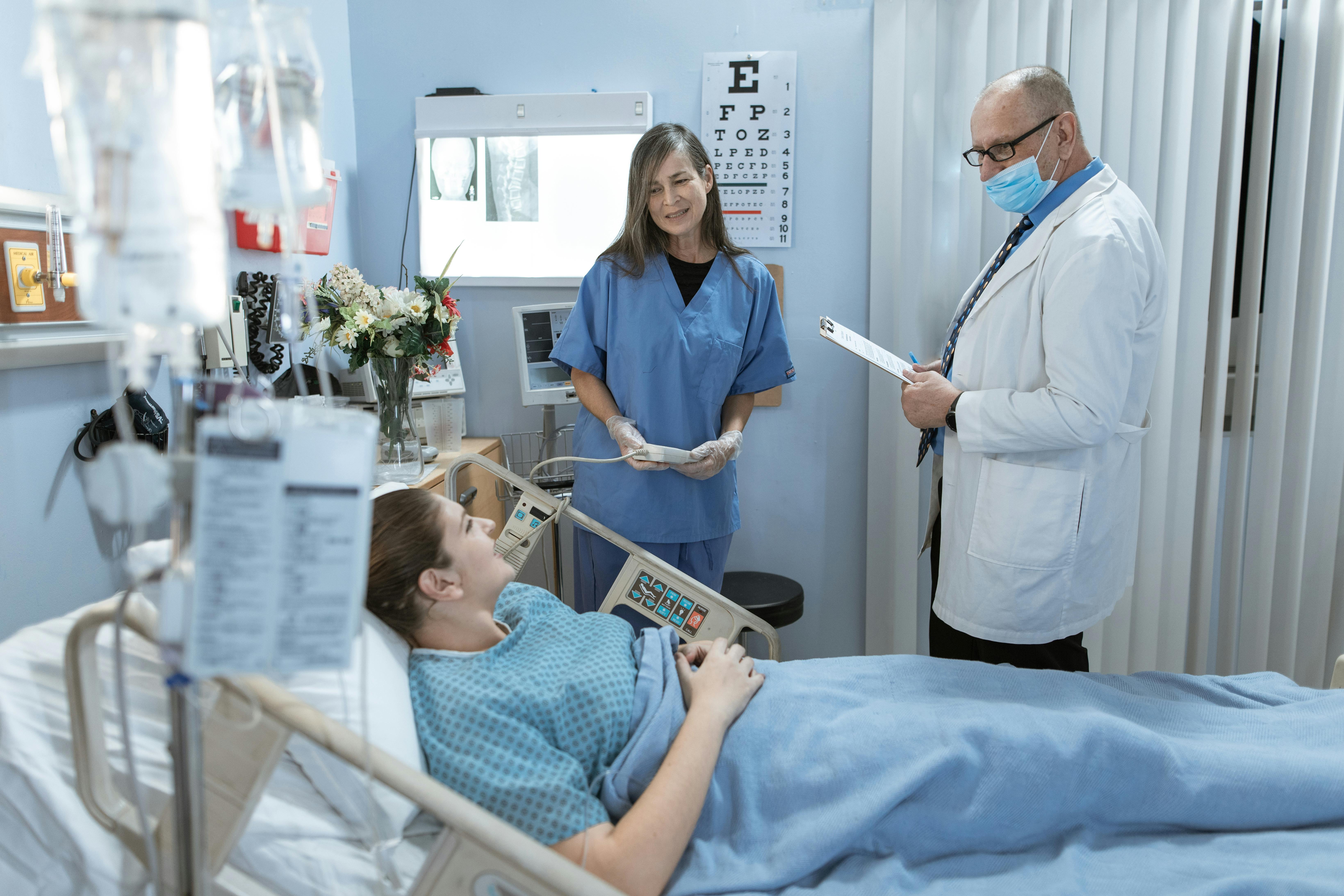Knee Replacement Explained- Things you Need to Know

Knee replacement surgery is highly effective and widely practiced, as highlighted by the American Academy of Orthopaedic Surgeons (AAOS). In fact, it's one of the most successful procedures in medicine, with over 790,000 surgeries performed annually in the United States alone.
During a knee replacement, the damaged joint surface is resurfaced with metal components, often separated by plastic inserts, to restore joint function. In some cases, the underside of the kneecap may also be resurfaced with plastic.
In this article you’ll learn every detail you need to know about knee replacement surgery, let’s go!
Table of Contents
- What is knee replacement and why is it useful?
- Why have knee replacement surgery?
- Types of Knee Replacement
- Who might need a knee replacement?
- Risks and complications
- Alternatives to surgery
- What you can do to prepare for surgery
- During the Procedure
- After The Procedure
- Q&A About Knee Replacement Surgery
- How can a doctor tell if you need a knee replacement?
- What tests are done to determine knee replacement?
- How bad does a knee have to be before replacement?
- Who Cannot have knee replacement surgery?
- What happens if you wait too long for knee replacement?
- How do I avoid knee replacement?
- Is knee replacement high risk surgery?
- Sources
What is knee replacement and why is it useful?
Knee replacement, also known as knee arthroplasty or total knee replacement, is a surgical procedure aimed at addressing knee damage caused by arthritis. This condition can severely impact one's quality of life, making everyday activities painful and difficult.
During the surgery, metal and plastic components are used to cover the damaged ends of the bones in the knee joint, including the kneecap. This helps restore smooth movement and function to the knee.
Arthritis can manifest in various forms, such as osteoarthritis, rheumatoid arthritis, or traumatic arthritis. Osteoarthritis, typically affecting older adults, leads to the breakdown of joint cartilage and bone in the knees.
Rheumatoid arthritis causes inflammation in the joint lining, resulting in pain and stiffness. Traumatic arthritis, stemming from knee injuries, can also damage knee cartilage.
The primary objective of knee replacement surgery is to alleviate pain and restore mobility by repairing the damaged parts of the knee joint.
This procedure is typically recommended when other treatment options have been unsuccessful in managing knee pain and improving function.
Why have knee replacement surgery?
Knee replacement surgery is a solution for managing pain and disability in the knee, commonly caused by osteoarthritis. This condition leads to the breakdown of joint cartilage, resulting in restricted movement and discomfort.
Individuals with severe osteoarthritis may find it challenging to perform everyday activities like walking or climbing stairs due to pain and instability in the knee joint.
Other forms of arthritis and knee injuries can also contribute to knee degeneration, leading to similar symptoms. When conventional treatments fail to provide relief, knee replacement surgery becomes a viable option.
Medical treatments for degenerative joint disease include anti-inflammatory medications, pain relievers, physical therapy, and assistive devices like canes.
In some cases, injections may be administered to alleviate pain and improve joint movement. Weight loss is also recommended for obese individuals to reduce stress on the knee joint.
Your doctor may suggest knee replacement surgery based on your specific condition and response to other treatments. It's essential to discuss your options thoroughly with your healthcare provider to determine the best course of action for managing your knee pain and improving your quality of life.
Also read How to prevent knee sprains (Guidelines)
Types of Knee Replacement
Knee replacement can be total or partial.
Total knee replacement (TKR) involves replacing both sides of the knee joint and is the most common procedure. The surgery typically lasts between 1 and 3 hours and aims to reduce pain and improve mobility.
However, scar tissue formation after surgery may make bending and moving the knees challenging.
Partial knee replacement (PKR), on the other hand, replaces only one side of the knee joint. This procedure involves removing less bone, resulting in a smaller incision. PKR is suitable for individuals with damage to only one part of the knee.
Compared to TKR, PKR offers advantages such as simpler post-operative rehabilitation, reduced blood loss, and a lower risk of infection and blood clots.
Additionally, patients undergoing PKR often experience a shorter hospital stay and recovery period, along with a higher likelihood of achieving more natural movement in the knee joint.
Your healthcare provider can help determine which procedure is best suited to your individual needs and condition.
Who might need a knee replacement?
Deciding on knee replacement surgery is a personal choice made in consultation with your doctor, but certain factors may indicate that it's the right option for you.
- Severe Arthritis: If you have osteoarthritis, rheumatoid arthritis, or postinjury arthritis causing significant knee damage, surgery may offer relief by replacing worn-out knee surfaces.
- Ineffective Nonsurgical Treatments: When medications, injections, and physical therapy no longer alleviate pain or restore function, surgery becomes a consideration as these treatments do not address the underlying cause of arthritis.
- Pain Hindering Daily Activities: If knee pain disrupts your ability to perform everyday tasks or care for yourself, surgery may be necessary to improve your quality of life.
- Persistent Pain, Even at Rest: Severe, constant pain that persists even when resting, and disrupts sleep, could indicate that surgery is needed.
- Chronic Swelling: Consistent knee swelling despite other treatments may signal advanced cartilage degeneration, warranting surgery.
- Deformity and Loss of Motion: Arthritis progression can lead to knee deformities and loss of motion, making knee replacement surgery necessary to restore function.
7. Acceptance of Activity Limitations: Understanding and accepting limitations on high-impact activities post-surgery is crucial for successful recovery and longevity of the artificial knee.
- Age Considerations: While knee replacements are more common in older individuals, age alone does not disqualify younger patients. However, younger individuals may need to manage expectations and avoid excessive stress on the artificial knee to maximize its lifespan.
Ultimately, the decision to undergo knee replacement surgery should be based on a thorough discussion with your doctor, weighing the potential benefits and risks based on your individual circumstances and lifestyle.
Risks and complications
Total knee replacements generally have low complication rates, but potential risks include:
- Infection: Occurring in fewer than 2 percent of patients, signs include fever, redness, swelling, bleeding, or increased pain around the surgical site.
- Blood Clots: Deep vein thrombosis (DVT) in the legs or pulmonary embolism (clot in the lungs) are possible, indicated by redness, tenderness, or swelling below the knee, and shortness of breath or chest pain, respectively.
Immediate medical attention is crucial if signs of infection or blood clots develop.
Other complications may include:
- Allergic reaction to bone cement
- Excessive bone formation around the artificial joint
- Excess scar tissue limiting knee movement
- Kneecap instability leading to painful dislocation
- Damage to ligaments, arteries, or nerves around the knee
- Dislocated kneecap or bleeding within the joint
- Implant surface wear causing loosening
If the replacement becomes loose, wears out, or if there's a severe infection or fall, further surgery may be necessary. Promptly reporting any concerns to your healthcare provider can help address complications early and ensure the best outcome post-surgery.
Alternatives to surgery
Depending on the severity of knee damage, several alternative procedures may be considered, although knee replacement surgery typically yields better long-term results.
For isolated kneecap damage, kneecap replacement may be performed, offering a swift recovery with a brief surgical procedure.
Mini-incision surgery (MIS) involves a small front knee incision, using specialized instruments for gentler joint handling, resulting in quicker and less painful recovery.
Image-guided surgery utilizes computerized imagery and infrared beacons, allowing surgeons to operate from another room, enhancing precision.
Arthroscopic washout and debridement involve flushing the knee with saline solution and removing bone fragments through tiny incisions. However, it's not suitable for severe arthritis cases.
Osteotomy involves cutting and realigning the shinbone to redistribute weight-bearing, delaying knee replacement in younger patients with limited arthritis.
Autologous chondrocyte implantation (ACI) introduces new cartilage from the patient's cells into the damaged area, matured artificially in a lab, primarily used in accidental injury cases.
Ultimately, the choice of procedure depends on individual circumstances, severity of knee damage, and expected outcomes, with consultation with a healthcare provider guiding the decision-making process.
What you can do to prepare for surgery
Prior to and after your surgery, it's highly recommended to quit smoking as it significantly increases the risk of complications and slows down the healing process.
Similarly, minimizing alcohol intake is advised as it can also lead to complications, impede healing, and affect sleep quality post-operation.
Engaging in exercises to strengthen muscles before surgery can accelerate recovery. This includes arm and stomach exercises to facilitate movement in and out of bed, as well as activities like walking, cycling, or swimming to improve overall strength and fitness.
Adhering to medication instructions provided at your preadmission/anaesthetic clinic is crucial for proper management of your condition.
Maintaining a healthy diet is essential for optimal recovery, as good nutrition supports the healing process. If overweight, undergoing a total knee joint replacement can be more challenging due to excess tissue around the knee, which may complicate surgery and recovery.
Even without weight loss, making dietary changes and engaging in exercise can help reduce the risk of complications following surgery.
While weight loss may be challenging, especially with limited mobility, incorporating exercise and dietary modifications can improve outcomes and reduce the likelihood of post-surgery complications.
During the Procedure
Knee replacement surgery typically involves a hospital stay and is performed under general anesthesia. Here's what generally happens during the procedure:
- You'll change into a gown and may have an IV line inserted into your arm or hand.
- You'll be positioned on the operating table, and a urinary catheter may be inserted if needed.
- The surgical area may be shaved if there's excessive hair.
- Throughout the surgery, your vital signs will be closely monitored by the anesthesiologist.
- The surgeon will cleanse the skin around the knee with an antiseptic solution.
- An incision will be made in the knee area.
- The damaged parts of the knee joint will be removed, and the joint will be resurfaced with a knee prosthesis made of metal and plastic.
- The prosthesis typically consists of three components: the tibial component for the shin bone, the femoral component for the thigh bone, and the patellar component for the kneecap.
- The incision will be closed using stitches or staples, and a drain may be placed to remove fluid.
- Finally, a sterile bandage or dressing will be applied to the incision site.
Each step of the process is carefully managed to ensure the best possible outcome for the surgery.
After The Procedure
After knee replacement surgery, you'll initially be taken to the recovery room for observation. Once your vital signs stabilize and you're awake, you'll be transferred to your hospital room. Typically, knee replacement surgery requires a hospital stay of several days.
Physical therapy starts soon after surgery to promote movement in the new joint. A physical therapist will create an exercise plan for you, possibly using a continuous passive motion (CPM) machine to gently move your knee while you're in bed. Pain medication will be provided to ensure you can participate in therapy.
Upon discharge, you may go home or to a rehabilitation center for further physical therapy until you regain strength and mobility.
At home, keep the surgical area clean and dry, following specific bathing instructions from your doctor. Pain relievers should be taken as directed, and notify your doctor if you experience fever, increased pain, or unusual symptoms.
To reduce swelling, elevate your leg and apply ice to the knee. Avoid driving until cleared by your doctor and follow any activity restrictions. Full recovery may take several months.
Prevent falls by using assistive devices like a cane or walker recommended by your therapist. Modify your home for safety, such as installing handrails and removing tripping hazards.
Your doctor may provide additional instructions based on your individual needs and recovery progress.
Also read Knee Replacement Discharge Instructions ( Detailed Info)
Q&A About Knee Replacement Surgery
How can a doctor tell if you need a knee replacement?
Knee replacement surgery may be recommended if you're experiencing severe pain, swelling, and stiffness in your knee joint, leading to reduced mobility.
If your knee pain is impacting your quality of life and disrupting your ability to sleep, it's a sign that the situation may warrant surgery.
Tasks that were once routine, like shopping or bathing, may become challenging or even impossible due to the pain and limitations in knee movement.
If these symptoms resonate with your experience, discussing the possibility of knee replacement surgery with your healthcare provider is crucial for exploring options to improve your condition and quality of life.
What tests are done to determine knee replacement?
Before your surgery, you'll undergo a series of tests to assess your overall health and ensure your body is prepared for the procedure.
These tests typically include a medical evaluation, blood samples, an electrocardiogram (ECG), a stress test, a chest X-ray, and a urine sample.
These tests help identify any underlying conditions that may require special attention or adjustments before proceeding with surgery. It's essential to complete these tests to ensure the safest possible outcome for your surgery and recovery.
How bad does a knee have to be before replacement?
Following knee replacement surgery, complete recovery may take several months, but the relief from pain and improved mobility can last for many years, possibly even a lifetime.
If you experience severe knee pain that significantly hinders your daily activities or moderate to severe knee pain even while at rest, day or night, it may be a suitable time to consider knee replacement surgery.
Discussing your symptoms and concerns with a healthcare provider can help determine if surgery is the right option for you based on your individual circumstances and needs.
Who Cannot have knee replacement surgery?
If the cartilage is thinning but hasn't reached the point of bone-on-bone contact, knee replacement surgery is generally not recommended, except in rare cases.
It's crucial for patients in such situations to explore alternative treatments and options that can effectively manage their condition without resorting to surgery.
Consulting with a healthcare provider can help determine the most appropriate course of action based on individual circumstances and needs.
What happens if you wait too long for knee replacement?
Delaying knee replacement surgery means subjecting your knees to more wear and tear over time, leading to escalating pain, stiffness, and mobility issues. Additionally, as your knee condition worsens, your overall quality of life may decline.
It's essential to consider these factors when deciding on the timing of knee replacement surgery, as addressing the issue sooner rather than later can potentially improve your comfort and mobility, enhancing your overall well-being and quality of life.
How do I avoid knee replacement?
There are several options to explore for managing knee pain:
- Low-impact exercises: Engage in activities like swimming or cycling that are gentle on the knees to help alleviate pain and improve mobility.
- Weight loss: Shedding excess weight can reduce pressure on the knees, easing discomfort and enhancing joint function.
- Physical therapy: Work with a physical therapist to strengthen the muscles around the knee, improve flexibility, and enhance overall joint stability.
- Knee brace: Consider using a knee brace to provide support and alleviate pain, offering an alternative to knee replacement surgery.
- Joint supplements: Explore the use of supplements like glucosamine and chondroitin to support joint health and alleviate knee pain.
- Injections: Corticosteroid injections can provide temporary relief from knee pain by reducing inflammation, while hyaluronic acid injections may help lubricate the joint and ease discomfort.
- Orthobiologic injections: These injections, containing substances like platelet-rich plasma (PRP) or stem cells, aim to promote healing and tissue regeneration in the knee joint, potentially offering relief from pain and improving function.
Discuss these options with your healthcare provider to determine the most suitable approach for managing your knee pain based on your individual needs and condition.
Is knee replacement high risk surgery?
As with any significant surgery requiring general anesthesia, there's a small chance of experiencing complications such as strokes, heart attacks, pneumonia, and blood clots.
Specifically, knee replacement surgery carries a risk of deep vein thrombosis (DVT), where blood clots form in the deep veins.
It's essential for patients to be aware of these potential risks and follow post-operative care instructions carefully to minimize them. If you have any concerns or notice unusual symptoms after surgery, it's crucial to inform your healthcare provider promptly for proper evaluation and management.
Sources



